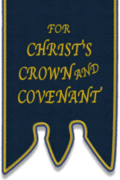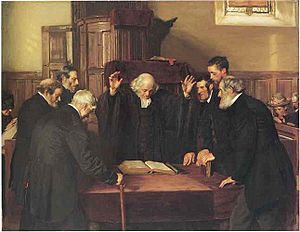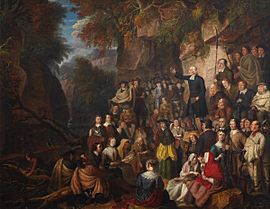Reformed Presbyterian Global Alliance facts for kids
Quick facts for kids Reformed Presbyterian Global Alliance |
|
|---|---|

The "Blue Banner" is a traditional symbol for Reformed Presbyterians.
|
|
| Type | Protestant |
| Theology | Reformed |
| Polity | Presbyterian |
| Structure | Communion |
| Origin | 1690 |
| Congregations | 156 (2021) |
| Members | 10,156 (2021) |
The Reformed Presbyterian Global Alliance is a worldwide group of Presbyterian churches. Their story began in Scotland in 1690. At that time, they separated from the main Church of Scotland because they disagreed with the government's control over the church.
Today, these churches form a global community, or communion. They have about 10,000 members in countries like Northern Ireland, Scotland, the United States, Canada, and Australia.
Contents
How the Church is Organized
Reformed Presbyterian churches have a presbyterian government. This means that each local church, called a congregation, is led by a group of elected leaders called elders.
The members of the church vote for the elders, who must be male members of that congregation. These elders, along with the pastor (also called a minister), form a council called a "session" that governs the church.
- Teaching Elders: These are the pastors or ministers. Their main job is to teach the Bible.
- Ruling Elders: These are other elected men from the congregation who help lead and make decisions.
All the different Reformed Presbyterian churches around the world work together through the RP Global Alliance. They call it a "consultative community," which means they meet to give each other advice and support.
What Reformed Presbyterians Believe
Reformed Presbyterians believe the Bible is the ultimate guide for their faith and how they live. They believe it is the inspired and perfect Word of God. They also use the Westminster Confession of Faith and the Westminster Catechisms, which are documents that summarize key Christian beliefs.
Their theology is described as:
- Protestant: Their history is part of the Protestant Reformation.
- Reformed or Calvinistic: Their beliefs are based on the teachings of John Calvin, a key Reformation leader.
- Evangelical: They believe in the importance of sharing their faith with others.
A very important belief for them is the kingship of Christ. This means they believe Jesus Christ is the king over everything, including governments. They believe that countries should recognize Jesus as their king and follow God's laws.
Worship in the Church
Reformed Presbyterians follow the regulative principle of worship. This means their worship services only include things that are directly commanded or shown in the Bible.
Because of this principle, they practice exclusive psalmody. This means that during worship, they only sing Psalms from the Bible. They sing without musical instruments, as they believe this is the way the early church worshipped.
The History of the Covenanters
Historically, Reformed Presbyterians were called Covenanters. This name came from their practice of making "covenants," or serious promises, to God.
The National Covenant
In the 1600s, King Charles I of England tried to force the church in Scotland to change its style of worship. Many Scottish ministers and nobles disagreed. In 1638, they signed the National Covenant at Greyfriars Kirk in Edinburgh. By signing, they promised to defend their form of worship. Their banner said, "For Christ's Crown and Covenant," showing their belief that only Christ, not the king, was the head of the church.
The Solemn League and Covenant
During the First English Civil War, the English Parliament was fighting against King Charles I. The Parliament asked the Scottish Covenanters for help. In 1643, they agreed to an alliance called the Solemn League and Covenant.
In this agreement, the Scots promised to help the English Parliament. In return, the Parliament promised to reform the Church of England to be more like the Presbyterian church in Scotland. This led to the creation of the Westminster Standards, which are still important for Presbyterians today.
A Time of Persecution
After the war, the monarchy was restored with King Charles II. He had promised to support the covenants, but he broke his promise. The government made the covenants illegal.
Most people went along with the new rules, but the Covenanters refused. They began holding secret worship services in the countryside called conventicles. This was illegal, and for many years, the Covenanters were harshly punished. This period, especially from 1679 to 1688, is known as the Killing Time. Many Covenanters fled from Scotland to Ulster in Ireland to escape.
A New Church is Formed
In 1688, a new king and queen came to power in what is called the Glorious Revolution. The Church of Scotland was re-established as a Presbyterian church, and most Covenanters rejoined it.
However, a small group of Covenanters still refused to join. They believed the church was still too controlled by the government, which did not officially recognize Christ as king. These dissenters formed their own groups, which eventually became the Reformed Presbyterian Church in Scotland. From there, the church spread to Ireland, North America, and other parts of the world.
Members Around the World
The Reformed Presbyterian Global Alliance is a communion of churches that all came from the original church in Scotland.
| Country | Denomination | Number of congregations | Number of members | Year |
|---|---|---|---|---|
| Australia | Reformed Presbyterian Church of Australia | 3 | 260 | 2021 |
| United States of America | Reformed Presbyterian Church of North America | 107 | 7,581 | 2021 |
| Ireland | Reformed Presbyterian Church of Ireland | 41 | 2,065 | 2022 |
| United Kingdom | Reformed Presbyterian Church of Scotland | 5 | 250 | 2022 |
| World | Reformed Presbyterian Global Alliance | 156 | 10,156 | 2021-2022 |
See also




